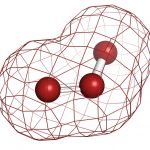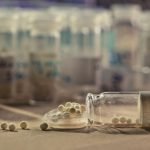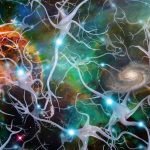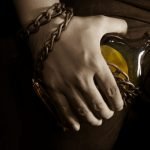When the Thoughts Drag Me Away
Joseph Kellerstein, ND
Francine has just left my office. She is grateful and very happy. It was not like this last week. In fact, I would say that she was uncontrollably tearful and highly over-reactive emotionally (that nasty medical word—hysterical).
Francine is of medium build and height with blond hair and has a voice that keeps calling out “help me.” This brave single lady is the sole support of her sons and a young grandchild. The family is beset by many problems that are unfortunately so common today—mental illness, drugs, and the like.
She came in early last week, sat down in my consult room, and began to weep uncontrollably. Her face was red and twisted with despair. On further observation, I noted her sighing. It was deep and frequently punctuated her anguished conversation. Notably, she was very afraid for her grandson, whose mother (with bipolar illness) suddenly wanted to take the grandchild for a time.
Francine describes her thoughts as “dragging her away.” She complains that she quickly imagines a catastrophe, creating a scenario in which mom might do something criminal to her son and where she would be helpless to protect the little guy. The force of this ideation is tremendous.
Francine is very involved with her church and during the conversation refers often to God and the need to be saved. She fears becoming insane. The patient seems bowled over by the speed and force of these thoughts.
Most concerning to her right now are the palpitations and a squeezing pain in the chest in the precordium extending to the back, which makes her feel as if she is on the verge of a cardiac event. She has had it checked, and there is no sign of organic concern.
Francine has had a history or responding well in acute emotional situations to Ignatia, so she has lots of it at home. This time, Ignatia offered some brief and mild relief but clearly not enough.

As you can see in the repertory chart, Ignatia does not refer to the chest pain with the extension that was so prominent in this case. Nothing here seems to me to be striking for Sulphur or Sepia.
Repertory charts are notorious liars. They were never meant to give us an unqualified answer to the problem of remedial selection. First, the repertory charts are only as useful as the peculiarity of the symptoms we enter. Second, please remember that rubrics are dumping grounds used by editors to place a symptom.
We cannot assume the meaning of an entry to be fully congruent with the title of the rubric. The only way to know the meaning of the entry is to read it from the original source in its full context. Furthermore, when we read from original sources, we should be circumspect and thoughtful. We also need to allow some latitude for surprise.
Let us read about Lilium tigrinum from T. F. Allen’s Encyclopedia of Pure Materia Medica:
- “Excitement, weeping, feeling as if she were two persons, at night (sixty-fifth day).”
- A seems as if “she were going to be crazy, if she did not hang on to herself, and hold tight.”
- “Apprehension of some calamity or serious disease very much increased.”
- “[C]an hardly keep from crying frequently, which is the opposite of her natural disposition.”
- “Constrictive pain about heart, through to scapula.”
The prescription was Lilium tigrinum 200D (1 dose). Francine said that she noted a sense of calm on leaving the office and soon the palpitations and pain in the chest eased. That night, she got the best sleep in a long time.
Over the weekend, she reached out to her church for help, and a prayer circle went to work for her. This makes her feel great.
You will notice that it took some work to individualize this acute case of emotional distress. It took effort to adapt the emotional experience so as to make it more repertorizable. The same goes for facilitating the patient’s sculpting of the physical symptoms for us. Then, the literature review took us back to our most reliable sources.
All of this occurs in the framework of constant individualization and the willingness to quickly dismiss my hypothesis in the face of contrary evidence and then to search out something better. Is there a more holistic approach than this?
Much of our ND community has graduated with a high degree of homeopathic illiteracy. Yet, knowledge of Hahnemann is a cornerstone of our understanding of holism, as is a good understanding of Traditional Chinese Medicine.
With all this eroding, we seem to be substituting a green allopathic approach. Patients are no longer individuals with lives that help form a system’s illness response. We are now a ball of enzymes and equilibrium equations to be pushed around. This approach is pleasing to the bottom line but not to the soul. It does not work nearly as well as holism. The battle cry of today’s ND is “protocol.”
As NDs, we need to take a hard look at why we are unique and what our role is in society. I can tell you that it is not because of supplement protocols and intravenous therapies. These are areas that a medical community looking for revenue can easily overtake. Our strength is not in supplement companies. They will go where the profits are.
It is in our vision of holism. I can tell you from quizzing interns who preceptor with me that they have no idea what holism means as it applies practically to everyday work.
Please let us remember our principles and educate our physicians by them.
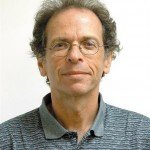 Joseph Kellerstein, DC, ND graduated as a chiropractor in 1980 and as an ND in 1984. He graduated with a specialty in homeopathy from the Canadian Academy for Homeopathy, and sub-sequently lectured there for two years. He also lectured in homeopathy for several years at CCNM; for eight years at the Toronto School of Homeopathic Medicine; and for two years at the British Institute for Homeopathy. Dr. Kellerstein’s mission is the exploration of natural medicine in a holistic context, especially homeopathy and facilitating the experience of healing in clients. Dr. Kellerstein is presently teaching a post-grad course in Hahnemannian prescribing with Dr. Andre Saine. Its mission is to promote excellence in the basics of homeopathic prescribing; case taking; repertory; Organon as applied to real-life practice; and case analysis skills via modeling the masters. The course runs for three years; distance learning is available. Students can preceptor in Dr. Kellerstein’s clinic, and mentoring is available.
Joseph Kellerstein, DC, ND graduated as a chiropractor in 1980 and as an ND in 1984. He graduated with a specialty in homeopathy from the Canadian Academy for Homeopathy, and sub-sequently lectured there for two years. He also lectured in homeopathy for several years at CCNM; for eight years at the Toronto School of Homeopathic Medicine; and for two years at the British Institute for Homeopathy. Dr. Kellerstein’s mission is the exploration of natural medicine in a holistic context, especially homeopathy and facilitating the experience of healing in clients. Dr. Kellerstein is presently teaching a post-grad course in Hahnemannian prescribing with Dr. Andre Saine. Its mission is to promote excellence in the basics of homeopathic prescribing; case taking; repertory; Organon as applied to real-life practice; and case analysis skills via modeling the masters. The course runs for three years; distance learning is available. Students can preceptor in Dr. Kellerstein’s clinic, and mentoring is available.





